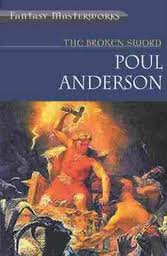Poul Anderson's fantasy novel, Three Hearts And Three Lions, was serialised in 1953 but not published as a book until 1961. Thus, Anderson's first fantasy novel in book form was The Broken Sword, published in 1954, the same year as his first science fiction (sf) novel, Brain Wave.
Thus, here are three beginnings:
Brain Wave was not only his first sf novel but also the first in which he speculated about interstellar travel;
Three Hearts... is the first of several fantasy novels that are set in alternative timelines but whose characters can meet in an inter-cosmic inn;
The Broken Sword (London, 1977) is the earliest of his fantasy novels to be set in our timeline - although it is not the first in chronological order of fictitious events because it refers to the sunken city of Ys which exists and is sunk in a tetralogy by Poul and Karen Anderson.
That The Broken Sword is set in our timeline is shown by the concluding words of the later written Foreword:
"As for what became of those who were still alive at the end of the book, and the sword, and Faerie itself - which obviously no longer exists on Earth - that is another tale, which may someday be told." (p. 12)
That tale was not told but the Foreword clearly places this version of "Faerie" in our past.
Chapter I of The Broken Sword is historical fiction. A Jutlander settles in England and marries a Christian but continues to offer to Thor, Frey, Odin and Aegir despite conflict on this issue with his Christian priest. So far, supernatural beings, including "...the White Christ..." are objects of belief and worship but not yet active subjects in their own right (p. 17). That is soon changed by the opening sentence of Chapter II:
"Imric the elf-earl rode out by night..." (p. 18)
So what might have remained historical fiction has become historical fantasy. But Anderson's Foreword suggested that the earlier, unrevised text had belonged to a different genre. It had contained "...rationalization..." with "...the dwellers in Faerie...technologically advanced beyond their human contemporaries..." and with their "...alien metabolism..." vulnerable to actinic light and to electrochemical reactions with iron (p. 11). That would have made this an sf novel.
The first volume of Tolkien's better known fantasy trilogy was also published in 1954. Thus, Anderson and Tolkien were approximately simultaneous in their adaptations of North European mythology into modern fantasy. However, it was Tolkien's success that made heroic fantasy respectable and thus enabled Anderson's novel to be republished later in revised form.
Tolkien ennobled the elves whereas Anderson kept them immoral, as in the Eddas and sagas. In that sense, his novel is more authentic.

1 comment:
Hi, Paul!
I disagree with your last sentences: "Tolkien ennobled the elves whereas Anderson kept them immoral, as in the Eddas and sagas. In that sense, his novel is more authentic." The problem is, many readers conclusions about how they thought Tolkien regarded the elves is based only from reading THE HOBBIT and THE LORD OF THE RINGS.
It would be more accurate to say the elves as we see them in the books cited above are what they became after being purged by sorrow and suffering. Anyone who reads THE SILMARILLION will see how some of the elves in past ages were cruel, ruthless, greedy, prone to wrath, etc.
Tolkien's problem was he could not persuade his publishers to print the "Silmarillion" material before or alongside LOTR. The publishers found it too baffling and strange. If some form of what was later THE SILMARILLION had been published in 1954, then we would have seen the elves changing as time passed, rather than the "finished product" we saw in LOTR.
I know many readers have trouble with THE SILMARILLION, but if we are to get a proper understanding of Tolkien's work, then what he says in that book has to be taken into account in evaluating the elves. BTW, I LIKE that book.
Sean
Post a Comment